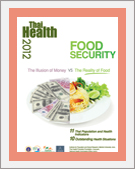
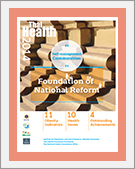 ThaiHealth 2014 |
 ThaiHealth 2013 |
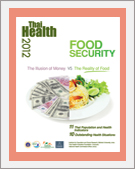 ThaiHealth 2012 |
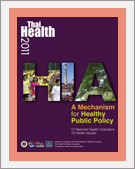 ThaiHealth 2011 |
 ThaiHealth 2010 |
|||
 ThaiHealth 2009 |
 ThaiHealth 2008 |
 ThaiHealth 2007 |
 ThaiHealth 2006 |
 ThaiHealth 2005 | |||
"Self-management Communities:" Foundation of National Reform
11 Obesity Indicators
10 Health Issues
4 Outstanding Achievements
With this volume, Thai Health has entered its second decade of existence. Over the last ten years, we have solicited readers’ opinions on how to improve Thai Health further. Most readers would like the content and format kept as it is, with only some minor changes. Those suggestions, including explanations for tables and graphs and the use of simple language have been incorporated into successive volumes of Thai Health.
This volume’s special feature entitled “Self-managing communities: Foundation of national reform” presents the stories of local communities whose strength allowed them to successfully achieve
their goals and overcome problems. Although differing in methods, these communities share certain characteristics such as broad participation and strong leadership. These strong communities, that can solve their own problems, make for a very strong foundation for sustainable national reform.
This year’s 10 outstanding health situations include some of the most debated government policies such as the rice-pledging scheme, the 2-trillion-baht loan and the 350-billion-baht water management mega-project as well as controversial social and environmental issues such as disgraced monks and the ICJ verdict on PreahVihear dispute. Four success stories are also presented: Thailand’s victories
in international sports; World Soil Day; Siriraj Hospital winning international prize for thalassemia researches; and DrKraisid winning international nutritionist award.
| Prepared by | Institute for Population and Social Research , Mahidol University | |||
| Supported by | Thai Health Promotion Foundation
The National Health Commission office |

Thailand Reform : Restructuring Power,Empowering Citizens
10 Human Security Indicators.
5 Outstanding Situations In The Past Decade.
10 Outstanding Situations In The Year 2013.
4 Outstanding Accomplishments for Health
Thailand Reform : Restructuring Power, Empowering Citizens
This volume of ThaiHealth marks the report’s first decade
of publication. During each of the last ten years, ThaiHealth
focused on the previous year’s outstanding issues, chronicled
key events and presented important information to the public.
Some of these situations described in our reports have seen
improvements while others are stuck without significant
progress in the same place or simply recurrent difficulties. In
order to solve complex problems we can understand that we
need a complete rethinking and restructuring of society, as well
as cooperation from all parts of the society itself.
In this 10th year anniversary volume, the ThaiHealth Working
Group has selected five important ongoing situations for discussion
and for each compiled related events chronologically to show a
clear picture of developments. The aim of this special volume is to
summarize actual events while avoiding analysis and commentaries.
ThaiHealth’s duty is to record events for the benefit of learning for
the future. The five situations chosen are: ongoing political conflict;
the Deep South unrest; sexual health issues; natural and other
disasters; and health system reform-a social innovation involving
government agencies, civil society and the public at large.
| Prepared by | Institute for Population and Social Research , Mahidol University | |||
| Supported by | Thai Health Promotion Foundation
The National Health Commission office |
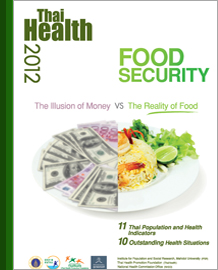
FOOD SECURITY : The Illusion of Money VS The Realiry of Food
11 Thai Population and Health Indicators
10 Outstanding Health Situation
For nine consecutive years, the Thai Health Working Group has been
issuing annual reports containing academic information on health
in its physical, mental, social, wisdom and cultural dimension. This
latest report, Thai Health 2012, focuses on food security so as to
reflect the ongoing insecurity in the global food market which
continues to experience many crises arising from toxic residue
to price hikes and increasing food shortages. These food related
problems are intensifying and deepening such that the general
public is increasingly worried and concerned about the safety and
quality of their lives.
The main section of this report discusses the different aspects of
food security. Food security is defined as “access for consumption by the
population to available and adequate food with safety and age appropriate
nutritional values for wellbeing as well as to ensure a secure food production
system which supports and maintains ecological balance and the country’s
natural food resource base in normal times as well as during natural disasters
and/or in case of terrorism threats against food supplies.”
This discussion article aims to shake Thai society from its position of
complacency regarding food issues so as to ensure the society begins to take
steps to ensure Thailand’s food security, with policy awareness that locally
produced food should serve, first and foremost, the Thai people. Although
food security is a recurring issue which has caused significant challenges in
the past, it is now time to raise awareness at a national level to ensure
effective policy making and concrete measures to prepare for future food
crises. Debunking the myth of fertility and food security, this report aims
to project the real situation where, as the Thai populer saying, “Money
is illusory, food is tangible.”
| Prepared by | Institute for Population and Social Research , Mahidol University | |||
| Supported by | Thai Health Promotion Foundation
The National Health Commission office |
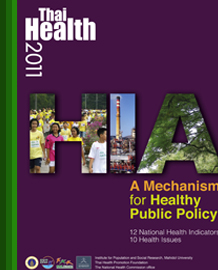
HIA : Mechanism for Healthy Public Policy
12 National Health Indicators
10 Health Issues
Many problems facing Thai society
today are like tests that require mindfulness
and wisdom to solve, so that Thailand can be a society
in which wellbeing and equality are truly realized. This Thai
Health report hopes to be a part of a process of reviewing past
xperiences, creating new alternatives and finding solutions to all the
problems that undermine wellbeing of Thais–whether that be an economic
crisis, clashes of opinions, violence in different levels of the social
structure or outdated attitudes that are lagging behind rapid social change.
Some articles, in this publication suggest new perspectives on social change. Some
examples include discussing a reproductive health law to address abortion and teen
pregnancy issues or an amendment to rape and sexual harassment laws in order to stop
“rubbing salt into the wounds” to victims. Such actions can lead to lasting solutions to
sex–related problems in Thai society.
Other articles covered here are follow–ups to issues that have been smoldering over the
past years, such as conflict in the Deep South, droughts and floods, political crises and
emerging diseases. This Thai Health report will continue to keep an eye on and update these
issues so as to constantly remind all sectors of Thai society of the need to come up with
effective solutions to existing challenges.
Thai Health 2011 also presents an important feature story on Health Impact Assessment
(HIA). HIA is a particular social mechanism to protect lives considering individual, communal,
social and environmental aspects that may otherwise be harmed by large government or
non-government projects such as industrial estates, mining or infrastructure projects.
The key feature of HIA is a participatory learning process which can include all members
in society.
This year’s “12 National Health Indicators” look at key indexes on the health status
of Thai people and Thailand’s health care system, some of which have witnessed
improvements in recent years but others that remain to be urgently addressed.
The 10 Outstanding Health Situations and 4 Achievements also record important
events in Thai society in past year. Some are updates of previous events while
others are emerging issues that require awareness and attention.
| Prepared by | Institute for Population and Social Research , Mahidol University | |||
| Supported by | Thai Health Promotion Foundation
The National Health Commission office |

Capitalism in Crisis : Opportunity for Society?
12 Health Indicators of Thailand's Workforce
10 Health Issues
This 2010 volume of Thai Health titled “Capitalism in Crisis:
Opportunity for Society?” probes into the central philosophy of
capitalism-profit maximization and economic growth on the back of
environmental exploitation-which lies at the root of many problems
such as pollution, global warming and social inequality. At the end of the
discussion, an open question is suggested: How can we, after so many
economic crises-turn this crisis into an opportunity using lessons we
have learnt about capitalism? How to replace the purely profit-seeking
capitalism with a new capitalism where the market processes are
regulated in an appropriate, transparent and just manner to benefit
society as a whole? The next part, Health Indicators, examines the
health situations of the Thai workforce. The twelve
dimensions include physical and mental health, quality
of life, financial situations, work safety, informal sector
workers and at-risk groups.This year’s Top Ten Health Issues, derived from a
public vote, looks into the four-years-old political conflicts,
the problem-ridden Map Ta Phut case, H1N1 pandemic flu
and other important topics.
| Prepared by | Institute for Population and Social Research , Mahidol University | |||
| Supported by | Thai Health Promotion Foundation
(Health Information System Development Programme) |

Stop Violence for Well-being of Mankinf
10 Health Care System Indicators
10 Health Issues
For
the 2009 report, As with previous issues, the report is divided
into 3 parts. Part one Health Indicators examines several
dimensions of the health care system: 1. Health service delivery
2. Human resources for health 3. Health information systems
4. Medical equipments and technologies 5. Health financing
6. Access and coverage 7. Quality and safety 8. Health equity
9. Social and financial risk protection 10. Efficiency
Part two considers Ten Health Issues. The first issue is the
political conflicts that have adversely impacted on the health of
the people in recent years. The second is the reemergence of
narcotic drugs; the third is the fuel price crisis and its impacts on
the poor; the fourth is Thais at risk of depression and suicide; the
fifth is the government’s introduction of compulsory licensing,
resulting in improved access to drugs among Thai people; the sixth
is sexual harassment in educational institutions; the seventh is
melamine in milk; the eighth is the fate of migrant workers from
neighbouring countries in Thailand; the ninth is AIDS and Thai
youth; and the tenth issue is the National Health Assembly, which
will become an important means for advancing social health. Part three of the report is a special article discussing the many
hidden dimensions of violence in Thai social and cultural
structures.
| Prepared by | Institute for Population and Social Research , Mahidol University | |||
| Supported by | Thai Health Promotion Foundation
(Health Information System Development Programme) |

Global Warming A Real Threat from Humans
13 Preschool Children Indicators
10 Health Issues
The 2008 edition of the Thai Health Yearbook the 5th issue released to the
public. As for this publication, the authors have selected the “hot” issue of “global
warming” and have included a special article in the current issue, “Global
Warming: A Real Threat from Humans” Thailand has faced global warming as have
other parts of the world due to various human activities that have released
greenhouse gases. Global warming is a severe problem which widely affects all
aspects of our lives. If the problem continues to worsen and human beings do not
try to limit and reduce greenhouse gases, there is an approximate probability of 50%
that the planet’s temperature will increase by more than 5 degree Celsius within the
next ten years. Such a rise in temperature would be catastrophic for certain areas.
Although human beings have started to realize the threat of global warming, the
world has not been able so far to reduce activities that have released greenhouse
gases.
The ten outstanding health situations covered in this issue represent some of the
key issues that have garnered public attention over the past year. For example, it is
widely known that the Southern unrest is a problem that has plagued the country for
the past four years and thus requires continued and that constant monitoring. Even
though some measures have been launched to decrease the frequency of the
violence, much more
Health indicators of this year were dedicated to the issue of “Preschool
Children,” which is considered a crucial age for brain and physical development.
This period is the best time to develop children’s thinking, writing, and
socialization skills in order to become good adults in the future. This age is really
a turning point to be able to memorize, increase their innovative thinking no
matter what their economic status, and create the This is the time when all
children, no matter what their economic status, develop their intelligent
quotients (IQ), the emotional quotients (EQ), moral quotients (MQ), and the
social quotients (SQ).
| Prepared by | Institute for Population and Social Research , Mahidol University | |||
| Supported by | Thai Health Promotion Foundation (Health Information System Development Programme) |

"The Scent of Lamduan Flower" Preparing an Aging Society
14 Health Indicators
10 Health Issues
The 2007 issues of the Thai Health Report, like the previous three,
takes a broad, multi-faceted view of health. The flower on the
cover, lamduan, is the official symbol of elderly people in
Thailand, and elderly people are this year's special topic. The
reason for focusing the elderly is not, as some might guess,
because the new government is composed mainly of elderly
people. Instead, it reflects current trends in the Thai population.
Thailand is slowly becoming an aging society. The proportion of
the population aged 60 or over was 5.5% in 1980, 7.4% in 1990,
and 9.5% in 2000.
The ten important health issues considered in the report include,
for the third time now, conflict in the South. This conflict
continues to affect the lives of people in the South and
throughout Thailand. It is intractable and complex. Many
different strategies for resolving the conflict have been tried and
have failed. Violence in the southern border provinces features
in the news every day, and even appears to be worsening. We
can only hope that the various parties to the conflict will soon
cooperate to find a solution.
A complete list of the 14 indicators is: (1) dementia: an Epidemic
on the horizon; (2) occupational health; (3) mental illness;
(4) happiness; (5) risk factors for cardiovascular disease; (6) risk
from secondhand smoke; (7) hazardous waste; (8) food
supplements (9) consumer protection; (10) income, savings, and
debt; (11) the suffi ciency economy; (12) Thai young people
gambling to get rich quick (13) Thai young people in the cyber
age. (14) educational inequalities.
| Prepared by | Institute for Population and Social Research , Mahidol University | |||
| Supported by | Thai Health Promotion Foundation
(Health Information System Development Programme) |

Facing the Challenge of Bird Flu
13 Health Indicators
10+10 Health Issues
The Thai Health Report 2006 contains three main sections. Section 1, Health Indicator, this year has 13 entries. Two entries deal with physical aspects of health: dental health and sexual health. Three entries deal with determinants of health: nutrition, alcohol, and exercise. There are entries discussing Thailand’s universal health care system, mental health, and spiritual health. There are also six entries discussing various aspects of social health: water shortages, traffic accidents, television versus school, family life, and pesticides.
Section2, 10+10Issues Currently Affecting the Health of Thais, discusses selected issues arising over the past year and their effect on people’s health.
Section3 Present this year’s special topic: “Facing the Challenge of Bird Flu”. Bird flu gas been a major public concern in Thailand, and will continue to be so for many year. As well as being a direct threat to people’s health, bird flu has affected the poultry industry, international public health cooperation, the economy, society, and Thai people’s way of life.
| Prepared by | Institute for Population and Social Research , Mahidol University | |||
| Supported by | Thai Health Promotion Foundation
(Health Information System Development Programme) |

Free Trade: A Double-Edged Sword for Thai People 's Access to Drugs
12 Health Indicators
10+10 Health Issues
The Thai Health Report, like this first one, has three parts. The first part, Twelve Health Indicators has 12 sections. Six of these sections look at physical health: deaths, illnesses, disability, pregnancy and birth, cancer nutrition. One section looks at mental health. Two section look at particular population: adolescents and elderly people. The final three sections discuss social health: poverty, environment, and human security.
The second part, Ten plus Ten Health Issues, discusses some recent events and their effect on health. This part uses a new format: it looks at ten notable issues for the year, and then briefly summarizes ten additional issues. It also looks back at the ten notable issues from the previous report, and describes any recent development. The third part of the report examines this year’s Special Issue : Free Trade in Medicines.
| Prepared by | Institute for Population and Social Research , Mahidol University | |||
| Supported by | Thai Health Promotion Foundation
(Health Information System Development Programme) |
